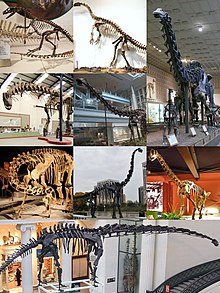
Back Sauropodomorpha Afrikaans أشباه سحليات الأرجل Arabic Zavropodomorflar Azerbaijani Sauropodomorpha Byelorussian সরোপোডোমর্ফা Bengali/Bangla Sauropodomorpha Breton Sauropodomorfs Catalan Sauropodomorpha CEB Sauropodomorpha Czech Sauropodomorpha Danish
| Sauropodomorphs Temporal range:
| |
|---|---|

| |
| Montage of nine different representatives of sauropodomorph dinosaurs. Clockwise from upper left: Eoraptor lunensis, Plateosaurus engelhardti, Brontosaurus excelsus, Europasaurus holgeri, Mamenchisaurus hochuanensis, Nigersaurus taqueti, Argentinosaurus huinculensis, Diplodocus carnegii, Brachiosaurus altithorax. | |
| Scientific classification | |
| Domain: | Eukaryota |
| Kingdom: | Animalia |
| Phylum: | Chordata |
| Clade: | Dinosauria |
| Clade: | Saurischia |
| Clade: | Eusaurischia |
| Clade: | †Sauropodomorpha Huene, 1932 |
| Subgroups | |
| |
Sauropodomorpha (/ˌsɔːrəˌpɒdəˈmɔːrfə/[2] SOR-ə-POD-ə-MOR-fə; from Greek, meaning "lizard-footed forms") is an extinct clade of long-necked, herbivorous, saurischian dinosaurs that includes the sauropods and their ancestral relatives. Sauropods generally grew to very large sizes, had long necks and tails, were quadrupedal, and became the largest animals to ever walk the Earth. The prosauropods, which preceded the sauropods, were smaller and were often able to walk on two legs. The sauropodomorphs were the dominant terrestrial herbivores throughout much of the Mesozoic Era, from their origins in the Late Triassic (approximately 230 Ma) until their decline and extinction at the end of the Cretaceous.
- ^ Langer, M.C.; Ramezani, J.; Da Rosa, Á.A.S. (2018). "U-Pb age constraints on dinosaur rise from south Brazil". Gondwana Research. X (18): 133–140. Bibcode:2018GondR..57..133L. doi:10.1016/j.gr.2018.01.005.
- ^ Cf. "sauropodomorph - definition of sauropodomorph in English from the Oxford dictionary". OxfordDictionaries.com. Archived from the original on November 1, 2015. Retrieved 2016-01-20.
© MMXXIII Rich X Search. We shall prevail. All rights reserved. Rich X Search